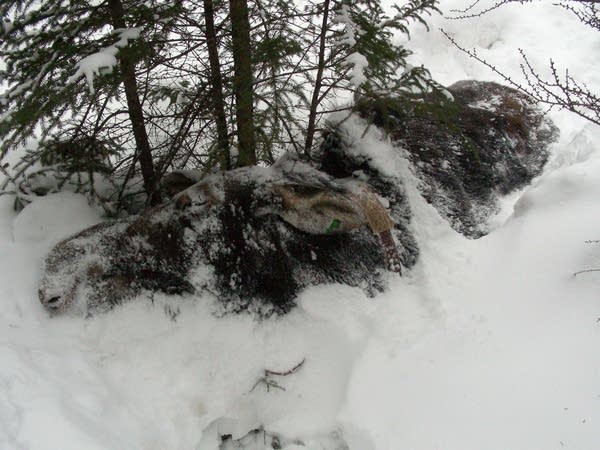The moose mystery
Go Deeper.
Create an account or log in to save stories.
Like this?
Thanks for liking this story! We have added it to a list of your favorite stories.

The trend is becoming clear and it's not good for Minnesota moose. After several years of decline, Minnesota's moose herd plunged last year. In one study with 35 radio-collared cows, a third died. Mark Lenarz monitors the herd, and he's worried.
"I am very concerned," says Lenarz, a DNR Wildlife Biologist in Grand Rapids. "I mean, moose is really the icon of the north. It isn't just moose hunters that like moose. It's basically everybody across northern Minnesota likes moose in this part of the state."

Consider this. The northwest Minnesota moose herd is only 84 animals. There were three times that many just four years ago. In Northeast Minnesota there are 6,500 moose, but that's down 23 percent from just a year ago, not including moose taken by hunters. Some moose are killed by cars or wolves, but most appeared to die in poor health.
For the past several years, Minnesota has been losing about 22 percent of its moose each year. That's more than twice the loss rate of moose herds in other places. But one year was different. Lenarz says the state only lost 9 percent back in 2004.
Turn Up Your Support
MPR News helps you turn down the noise and build shared understanding. Turn up your support for this public resource and keep trusted journalism accessible to all.
"The summer of 2004 was a very cool year," Lenarz says. "And last summer was a very hot year. And it's very tempting to make some sort of inference about global climate change or global warming based on that sort of information."
But he says it's more complex than that. Moose can be afflicted by parasites like winter ticks, liver flukes, and brain worms. Lenarz says moose deaths could come from the combination of stressors.
"For a healthy human, pneumonia isn't necessarily all that serious a disease," Lenarz says. "But if you get an older person pneumonia can be a very deadly disease. And I think the same thing could be occuring with moose, that if they're really heavily stressed by the summer heat then they can become vulnerable to a lot more of these diseases and parasites that they normally wouldn't die from."
Moose is really the icon of the north. It isn't just moose hunters that like moose.
University of Minnesota climatologist Mark Seeley says the temperatures have been rising in northern Minnesota. The mean temperature last summer rivaled the notoriously hot summer of 1936. But those statistics don't tell the whole story. The real difference isn't seen in the daytime.
"The summer maximum temperatures seem to be rather stable, or in decline," Seeley says. "But the overnight minimum temperatures are steeply upward. So that what's happening up there is that we're not cooling off at night."
And something else stands out. Northern Minnesota has been getting waves of high humidity more typical of summer in the southern part of the state. Seeley says that shows up in high dew points.
"There are times during the summer, when the dewpoint now is so high - this has happened eight of the last nine summers, I might add - that the weather service has had to issue a heat watch and a heat advisory because the heat index has gone above 105," says Seeley.
The combination of heat and humidity can be tough - even lethal - for some people, livestock and wildlife like moose. So, it may not be just the heat. It might be the humidity.

Researchers are scrambling to find out what's happening. Mike Schrage is a wildlife biologist with the Fond Du Lac band of Ojibway in Cloquet. If something doesn't change, he says, moose may become rare in Minnesota.
"I don't think we'll ever lose moose entirely, unless climate change is a whole lot worse than I think it's going to be," Schrage says. "But some of the recent reports (are) saying it's happening at a faster rate than folks were earlier anticipating. So, depending on what that relationship is and how things continue, I think, certainly in my career, we're going to struggle more and more to keep moose in Minnesota."
The biologists will be going through five years of radio collar data, and matching that with weather data. They might be able to figure out what's killing the moose, but they might be helpless to do anything about it.
Meanwhile, applications are being taken for 233 moose hunting permits the state will issue this year.




